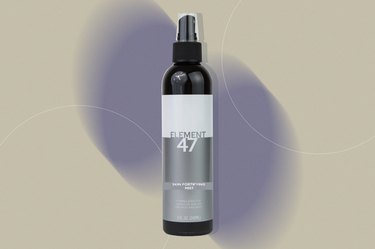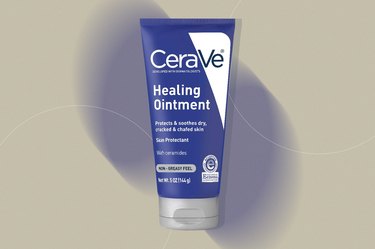
A rash or skin irritation can develop anywhere skin folds exist on the body. These fat folds can trap heat, moisture, bacteria and yeast inside, and combined with chafing, this leads to a condition called intertrigo.
"Intertrigo" is the term used to describe a rash between any two body folds, says Robin Ashinoff, MD, board-certified dermatologist and fellowship-trained Dermatologic, Mohs and Laser surgeon at Hackensack University Medical Center in New Jersey.
Video of the Day
Video of the Day
"Intertrigo is inflammation of the skin folds caused by friction," adds board-certified dermatologist, Shoshana Marmon, MD, PhD, assistant professor and director of clinical research in the Department of Dermatology at New York Medical College. Increased temperature and moisture within the folds are other contributing factors.
The condition commonly develops on the thighs, neck or diaper area in children. In adults, common areas of the body include under belly fat and breasts or in the armpits. Having any type of overhanging or excess skin puts you at risk for developing intertrigo.
Intertrigo can be uncomfortable, red and itchy, and it can lead to other skin issues such as sores. So if you're looking to treat intertrigo at home, here's what dermatologists recommend.
1. Keep the Skin Clean and Dry
The first step when dealing with any type of skin irritation is to keep the area as clean and dry as possible, Dr. Marmon tells LIVESTRONG.com. She recommends first cleaning any affected areas with water and using a gentle soap like Cetaphil Pro Restoraderm Soothing Wash ($15.89, Amazon.com).
After cleansing the area, pat it dry with a towel — don't rub! — and if necessary, you can also dry the area with a blow dryer on a cool setting.
2. Apply a Barrier Cream
One of the ways you can help your skin heal properly — and prevent intertrigo from getting worse — is to create a moisture barrier, Dr. Ashinoff tells LIVESTRONG.com.
After you've made sure the affected area is clean and dry, she suggests applying a barrier cream of zinc oxide paste, such as a diaper rash ointment. This helps create a "seal" to block moisture from seeping in and causing irritation.
Dr. Marmon notes that using a barrier cream with zinc oxide or an ointment with petrolatum can also help prevent skin or fat folds from rubbing against each other, which is another source of irritation.
Note that if your doctor has prescribed a treatment cream, you should apply that to your skin first, then, once the infection has cleared up, apply the barrier cream to keep moisture out.
Try These Products
- Globe Zinc Oxide Ointment ($4.99, Amazon.com)
- CeraVe Healing Ointment ($12.29, Amazon.com)
- Boudreaux's Butt Paste ($14.26, Amazon.com)
3. Protect the Skin With Pads
Along with keeping the skin clean and dry and using a barrier cream, Dr. Marmon says you can help physically keep skin folds apart and prevent them rubbing together by using a physical barrier as well.
For instance, she suggests placing Telfa pads or cotton gauze between the fat folds to keep them separated and eliminate friction.
Try These Products
- Telfa Non-Adherent Dressing Pads ($10.49, Amazon.com)
- Band-Aid Brand Medium Gauze Pads ($6, Amazon.com)
4. Use an Anti-Fungal
Sometimes, what you think is just irritation is actually a yeast or fungal infection — usually from a Candida infection — masquerading as a rash. For instance, if you have a rash under your belly fat or a sore under your belly fat, especially one that won't go away with other treatment, it could be a yeast infection within the folds.
"The moist environment in the skin folds is the perfect breeding ground for yeast, fungus or bacteria, which can worsen the irritation and rash," Dr. Marmon explains.
A yeast infection under belly fat can be very uncomfortable and itchy, so it's important to treat it correctly before it gets worse or infected from scratching. It's always best to have a fungal infection diagnosed by a doctor, but fortunately, Dr. Ashinoff says that if it is a yeast infection, a simple over-the-counter anti-fungal cream like Lotrimin ($8.10; Amazon.com) can be used effectively.
If you have diabetes, Dr. Ashinoff notes that you're at increased risk for candidal and fungal infections. If you develop a rash, then, you should make sure to take preventive steps — like washing and applying a barrier cream — to keep candidal infections at bay.
5. Protect With a Powder

To keep the area dry and help combat a fungal infection, you might want to consider using an anti-fungal powder, Dr. Marmon says.
A powder like Zeasorb ($13.36 for 2, Amazon.com) or Medline Remedy ($9.40, Amazon.com) can help control moisture between skin folds, and the ingredient miconazole nitrate can help stop the growth of yeast.
6. Fix It With Vicks
Anecdotally speaking, some people who have been plagued with under-the-breast skin irritation and yeast infections have found relief from none other than Vicks VapoRub ($7.99, CVS.com).
And there may be some truth to it: A 2011 study in the World Journal of Pediatrics found that applying menthol to the skin was an effective treatment for fungal infections between skin folds.
Just be sure to run this remedy by your doctor first, and discontinue use if any additional skin irritation occurs.
7. Combat Itch
Any type of open sore or rash should be evaluated by a doctor. Dr. Marmon says if you're mostly dealing with inflammation and itchiness under your belly fat, it can help to add a low-potency steroid cream such as Aveeno Maximum Strength Formula ($9.98, Amazon.com), which contains 1% hydrocortisone. However, steroids can worsen a fungal condition, so it's best to consult a doctor before attempting treatment.
8. Try a Toner

Dermatologist Leslie Baumann, MD, CEO of Skin Type Solutions Inc., tells LIVESTRONG.com that her favorite product for intertrigo or a yeast infection under belly fat is Element 47 Skin Fortifying Mist ($25, SouthLakeDermatology.com).
"It changes the skin's environment, making it less hospitable for fungi and bacteria," she notes. "I have had great results with it for intertrigo, and it will help sores heal, too."
9. Apply Aloe or Argan Oil
For a standalone rash, Dr. Baumann recommends applying argan oil or aloe. Indeed, a January 2019 review in the Iranian Journal of Medical Sciences of more than 23 different studies found that aloe vera can be effective as a skin-healing aid.
The International Journal of Molecular Sciences explains that argan oil also has been found to have helpful properties in restoring the skin's barrier function, as well as hydrating the skin, which can help heal infections.
When to See a Doctor for a Skin Rash
A rash between skin folds could be caused by a number of things, from moisture to bacteria build-up to a fungal infection. The first thing you should do if you develop a skin rash, especially between skin folds, is see a doctor.
Diagnosing the rash can help ensure that you treat it appropriately. Throwing a skin cream on what's actually a fungal rash, for instance, won't actually do anything, so it is important to get the right type of treatment for the cause behind the rash.
And according to Dr. Ashinoff, seeing a doctor as your first step for a skin rash or intertrigo will most likely save you time, frustration and even money, because a prescription or even an over-the-counter remedy will probably be much more effective than a home remedy. A professional diagnosis helps to identify the specific cause(s) of the condition, leading to a more targeted treatment.
Dr. Marmon also recommends that you see a dermatologist for any symptoms that include:
- Skin breakdown
- Worsening pain or tenderness
- Increasing redness
- Drainage from the site
- Fever or chills
- Persistent rash and irritation despite treatment
- Foul smell
- Vesicles or blisters in the area that may indicate the presence of an infection
- Iranian Journal of Medical Sciences: “The Effect of Aloe Vera Clinical Trials on Prevention and Healing of Skin Wound: A Systematic Review”
- International Journal of Molecular Sciences: “Anti-Inflammatory and Skin Barrier Repair Effects of Topical Application of Some Plant Oils”
- World Journal of Pediatrics: “Role of menthol in treatment of candidial napkin dermatitis”
Was this article helpful?
150 Characters Max
0/150
Thank you for sharing!
Thank you for your feedback!
Is this an emergency? If you are experiencing serious medical symptoms, please see the National Library of Medicine’s list of signs you need emergency medical attention or call 911.
